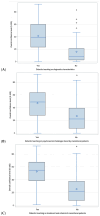Identifying Gaps in Predoctoral Craniofacial Education
- PMID: 40559169
- PMCID: PMC12192217
- DOI: 10.3390/dj13060266
Identifying Gaps in Predoctoral Craniofacial Education
Abstract
Background/Objectives: It is essential that dental school graduates are adequately prepared to provide care to patients with craniofacial differences (PCD). This study aimed to identify potential educational deficiencies in predoctoral dental school curricula regarding the management of PCD. Methods: An electronic survey was distributed to predoctoral dental students across the United States. The 20-item questionnaire assessed students' educational experiences, clinical encounters, and perceived knowledge and confidence in managing PCD. Results: The most taught didactic topic was diagnostic characteristics of craniofacial differences (77.1%), followed by psychosocial challenges (43.0%) and treatment/referral (36.3%). Respondents reported low levels of understanding and confidence in managing craniofacial conditions, with the lowest confidence in providing surgical treatment (30.1 ± 27.9) and the highest in referrals and communication (41.7 ± 30.1, on a 0-100 scale). Logistic regression showed that overall understanding was a significant predictor of confidence, increasing odds by 8% (OR = 1.08, 95% CI 1.05, 1.12). Participants noted that hands-on clinical experience would most improve their confidence in managing PCD. Conclusions: Predoctoral dental students exhibit low confidence and understanding in managing PCD. Incorporating more targeted craniofacial education, particularly hands-on clinical experience, into the curriculum is essential to better prepare dental graduates for craniofacial care.
Keywords: craniofacial abnormalities; dental education; predoctoral education.
Conflict of interest statement
The authors declare no conflicts of interest.
Figures






References
-
- Association TACPC Find A Care Team. [(accessed on 22 June 2024)]. Available online: https://acpacares.org/find-a-care-team/?tax%5Bacpa_team%5D%5B0%5D=9.
-
- Brown M.I., Kuyeb B.K., Galarza L.I., Benedict K.C., Hoppe I.C., Humphries L.S. Travel Burden to American Cleft Palate and Craniofacial Association-Approved Cleft and Craniofacial Teams: A Geospatial Analysis. Plast. Reconstr. Surg. 2025;155:140–149. doi: 10.1097/PRS.0000000000011410. - DOI - PubMed
-
- Parameters of Care for Evaluation and Treatment of Individuals with Cleft Lip/Palate and/or Other Craniofacial Conditions. [(accessed on 5 May 2025)]. Available online: https://njcraniofacialcenter.com/wp-content/uploads/2025/05/2024-ACPA_Pa....
Grants and funding
LinkOut - more resources
Full Text Sources
Medical

